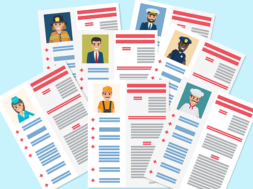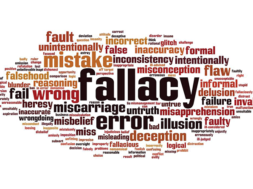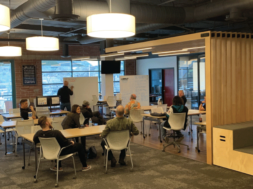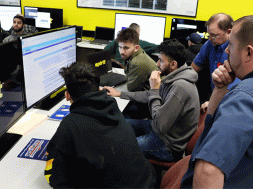
Working with Workforce Development
By Burke Malin, Chief Operating Officer, Gurnick Academy of Medical Arts
The efficacy of any higher education program can only be measured by meeting the desired outcomes of its graduates. For most graduates, this is a career within their chosen field of study. Regardless of the greater focus of employment outcomes, the main goal is to help people improve their lives with education. To do this, it is of utmost importance to think differently about who the customer of higher education is – the employers!
The main goal of technical colleges is for graduates to obtain employment. Period. Yet, historically, job placement was regarded more as a compliance measure and only then a measure of institutional achievement. This needs to shift.
By making graduate employment the ultimate measuring stick of institutional success, not only does the focus of every department within a campus shift, but it also ensures an institution’s viability and long-term success.
When graduates achieve gainful employment, many other success metrics fall into place. However, gainful employment does not happen by accident. It starts by taking an honest look at how graduates currently gain employment. Do graduates find their own jobs through an individual search? Is it reporting time and suddenly all hands are on deck with career services staff members, instructors, and program directors calling their networks to find last minute job openings? These scenarios are the reality for many technical colleges. Conversely, the strategy should be to engage employers proactively for hiring needs and have them regularly communicate directly with your campuses for graduates. So how does a school become an institution of choice for employers in a community?
Employer engagement is the key to creating successful program outcomes. Unfortunately, for too many schools, employers are only called when a student is eligible for an externship site or when an institution is in a time crunch to make a placement goal for the current reporting season. True partnership development happens when institutions stop looking at the short-term problem (placement) and start taking an intentional interest in workforce development efforts of the communities and business partners served.
What does an intentional interest in community and partnership development look like? There are three main paths to being recognized as an institution of choice by the employment community:
1. Student Preparation
2. Employer Input
3. Employer Participation
Student preparation is more than excellent training in the field of study, it is what employers expect. To stand out as an employer’s school of choice, institutions must understand specific site requirements, systems in use, company culture, and other hiring priorities. When possible, modifying the curriculum to address local hiring priorities is a guaranteed way to stand out as a partner. For larger employers, offering site-specific continuing education opportunities on software programs in use or competency development that falls outside of your school’s core curriculum, demonstrates flexibility and an investment in the employer partner’s success. Even if this additional education is offered at no cost, it can generate a great deal in financial returns. Think of this expenditure as marketing and consider the cost reductions to your organization due to decreased placement and affiliation agreement acquisition costs.
In addition to custom curriculum tracks, soft skill development is an essential component and cannot be ignored during the educational process. Soft skills surrounding employer interactions should be an integrated part of the student journey allowing these skills to mature over time. From a leadership perspective, it needs to be understood by all faculty and staff that they are collectively responsible for the employment outcomes of the graduates. This is a paradigm shift for many educational institutions and one that requires top-down leadership. When faculty have a myopic view of their responsibility to instruct core curriculum, they do not understand the importance of integrating critical employment readiness topics like teamwork, managing conflict, and time management into the core curriculum. They must understand their essential role in the employment process. Faculty pushback is often a symptom of feeling uncomfortable teaching professional development topics in which they themselves are not subject matter experts. School leadership can avoid this challenge by mapping out an integrated career development journey across the student lifecycle, identifying particular soft skills to be taught in specific courses, arming faculty with a robust professional development curriculum and engaging career services staff in this process. By providing discussion prompts, lecture presentations, simulations, and activities, faculty are more receptive to the concept and willing to bring these topics to life in the classroom. The career services professional at our schools now becomes a key part of the educational team. Career service’s ability to professionally interact with employers and seek their input becomes a core part of their job.
Employer input in the student preparation process or organizational initiatives can be solicited in several ways. Career colleges are no strangers to hosting advisory boards and facilitating frequent curriculum reviews. However, when an employer partner offers their valuable time and contributions to an advisory board, what an institution does with the information they provide goes a long way in establishing long-term trust. An advisory board is not a time to check the box of regulatory compliance, rather, it is an opportunity to allow partners to provide targeted input. It is time to treat partners like REAL partners. When employers see action has been taken, trust forms and they too are invested in institutional success. Remember, trust is established when your institution’s credibility and motive are known. For example, if an employer attends sequential advisory boards and notices their contributions/input has not been heard, the employer will see requests such as increased externship places as self-serving. In other words, the relationship will be perceived as one way rather than a partnership. At this point, your interactions with the employer will be seen as sales activities rather than mutually beneficial partnership activities. Presenting an untainted motive of partnering will guarantee access and communication with these employer partners.
In addition to advisory boards, it is important that the brand ambassadors, often career services, are attending community events.
When they arrive at a Chamber of Commerce meeting or an industry event, they must have a seat at the table. This occurs by first educating career services and outreach staff on the employment market in your local area. ONETonline.org does not tell the entire story of local hiring trends and market demand. You must dig deeper after establishing trust with employers to seek out internal or sector papers/studies they use to make workforce decisions and strategies in their organizations.
Considering that the role of career services has transformed into a partnership management position, staff members need to possess the business acumen to establish meaningful relationships with workforce development directors, general managers and the like. Successful institutions must take a hard look at the hiring profile for the department and consider revising the job description, attributes of candidates, and the screening process for the department. What does it take to stay up to date on industry trends and build meaningful partnerships with the employment community? The transactional sales representative mentality does not work, nor does the compliance-focused administrative personality type. Career services staff should embody the strongest business acumen and emotional intelligence on your team. Five key attributes have been found amongst top performers in this field:
- Intrinsic curiosity: Intrinsic curiosity means that this person will consider themselves a student of their industry. They will proactively keep up on legislation that impacts the employment sectors they serve and often become the industry experts that employers reach out to when they are seeking information on industry trends.
- Consultative sales approach: A consultative sales approach means that this person is not calling an employer to ask if they have any openings. Rather, they are taking on their employer partners goals and challenges as if they were their own.
- Confirm commitments: The ability to confirm commitments means that the career services staff member will be able to close a partnership meeting with clear, timebound, actionable steps that accelerate the business partnership in both directions. This skill is also important as it relates to candidate preparation and confirming graduate employment.
- Passion: Individuals that thrive in career services must be fueled by seeing graduates improve their lives through employment. An emotional attachment to education while supporting graduate success will improve department retention and long-term success.
- Drive: Successful career services staff members are self-motivated to structure their day around partnership generating activities. They are resilient when a graduate’s interview does not go as planned and have the emotional intelligence to resolve issues on the spot.
Once the right players are on the career services team, they will come to employer partnership meetings with their research on new regulations completed ahead of time. They will have already reviewed regional reports that forecast sector needs. Partnership meetings become more about understanding the employer’s definition of a “Job Ready” candidate and collaborating on their internal staff attrition and development strategy. Needless to say, the new career services professional is no longer an entry-level placement coordinator.
Finally, it is important that career services not combine partnership meetings with graduate placement or clinical site requests (placement and clinical requests are a natural byproduct of an established employer partnership). Gaining partnership insights does not happen without trust. The right to ask is earned. Again, by refraining from such requests, your motive is kept clear through demonstrating the focus on the partnership and not by promoting an internal school need. Credibility is further bolstered by Career Services expertise being brought to bear on the employer’s needs. Trust = Credibility + Motive.
To elevate relationships with the employment community even further, successful institutions invite employers to participate in business practices. At the program level, inviting employer partners to speak on campus not only demonstrates that their subject matter expertise is valued, but it also allows them to tour campus operations, experience the quality and academic rigor in the classroom, and preview potential new hires that are nearing graduation. Students simultaneously gain enthusiasm about prospective employment and thus persistence to graduation improves. For employers that consistently hire graduates, creating micro-credentialing tracks that align with their specific business practices and scope of work ensures that graduates are “Job Ready” for their facilities and differentiates graduates from other educational offerings in the area.
Employer participation at the next level could involve inviting HR or hiring managers of the employers to join the screening/interviewing process during admissions. This can be especially helpful for admissions interview processes for students applying to more rigorous programs (for example in allied health schools, programs like nursing or medical imaging). An employer will be more invested in the student training and employment at their organization when they are included in the admissions strategy and/or process.
This also applies to staffing for career services positions. If the career services representative is going to manage the day to day employer relationship, it is important that they have a strong rapport. Again, employers are much more invested in the relationship if they can be included in the hiring strategy and process.
Another example of employer participation includes fostering employer’s direct communication with students and alumni.
This communication can take place through technology platforms that allow employers to post job orders, share articles, and participate in student/alumni community forums. Technology platforms, like Career EDGE, also allow employers to reverse search graduates from one dashboard and capture all employer partner search analytics for career services to review and analyze. By maintaining an ongoing communication platform with students, alumni, and employers, employers are able to hire more experienced graduates. Another benefit of this type of communication platform is that alumni continue to feel the value of the educational experience long after they’ve graduated and started their careers. Staying connected to alumni in this meaningful way, establishes a built-in market for continuing educational offerings while allowing career services to identify alumni that have ascended to hiring manager positions. Who better to hire our graduates than our graduates!
In closing, it is critical to establish trust with workforce development partners by demonstrating sector credibility while arming career services staff members with on-going education regarding local labor trends and industry updates. Additionally, it is critical that value is continuously provided to employer organizations by offering customized solutions for their hiring and training needs. Furthermore, a mechanism for ongoing employer communication with a proprietary platform or a career services management system should be established. Finally, a top-down institutional focus on graduate employment as the ultimate success measure of the institution should be a top priority.
BURKE MALIN joined Gurnick Academy of Medical Arts as the COO in 2011. Prior to that, he was the Managing Partner of a consultancy dedicated to working with organizations on growth, marketing processes, financial management, leadership development, strategic direction, and organizational effectiveness.
Over the past eight years, he has focused on developing innovative relationships between vendors, employers, and clinical partners ultimately creating truly productive partnerships helping Gurnick grow to six campuses in California and increase revenue fourfold over the same period of time.
Burke has presented at many annual sector conferences including CAPPS (California Association of Private Postsecondary Schools), ABHES (Accrediting Bureau of Health Education Schools), and CECU on topics including management, employee development, alumni development, workforce development, and gainful employment topics. In his spare time, Burke continues to participate in one of his lifelong passions as a youth hockey coach in Northern California.
Contact Information: Burke Malin // Chief Operating Officer // Gurnick Academy of Medical Arts // 650-558-9038 // bmalin@gurnick.edu // gurnick.edu










